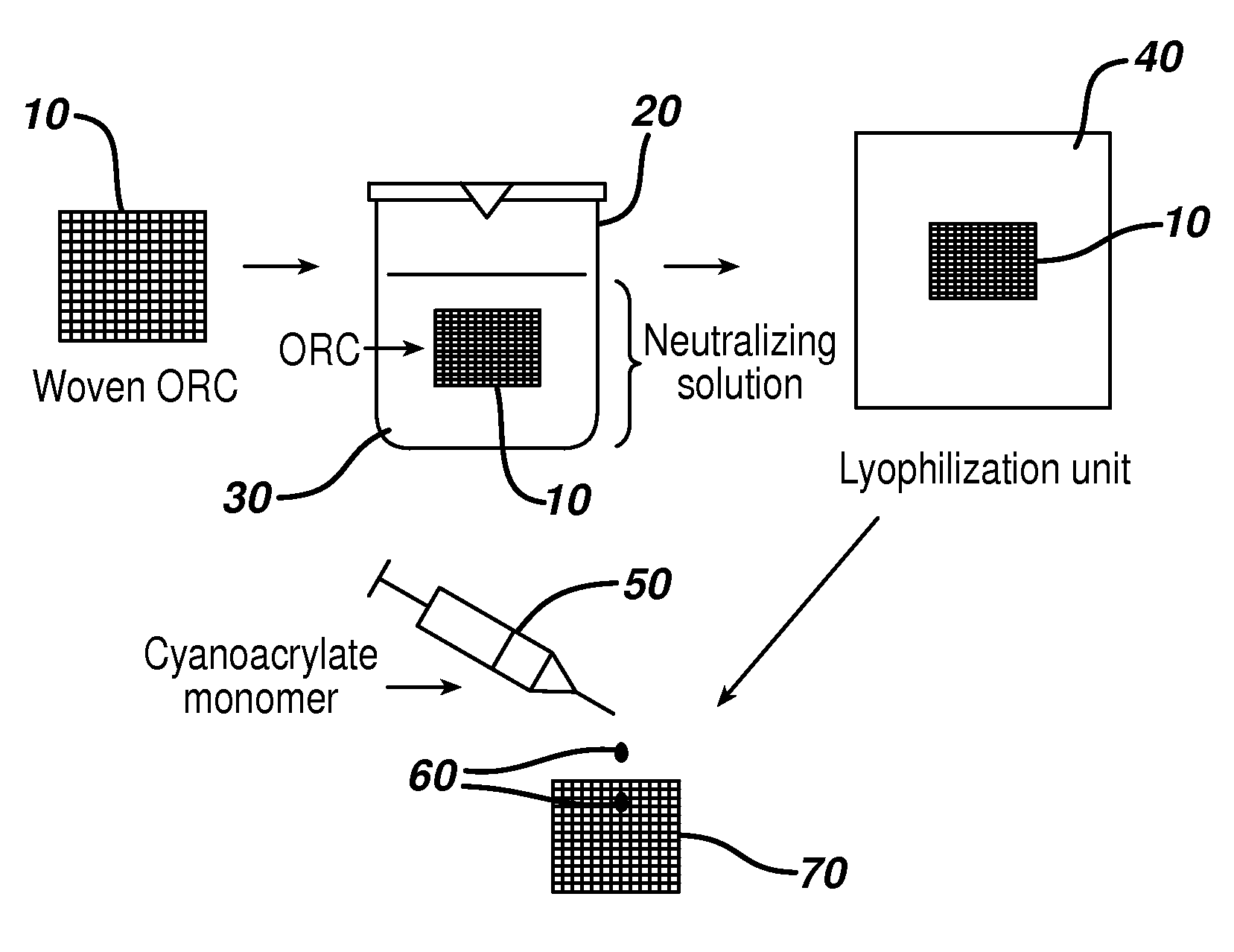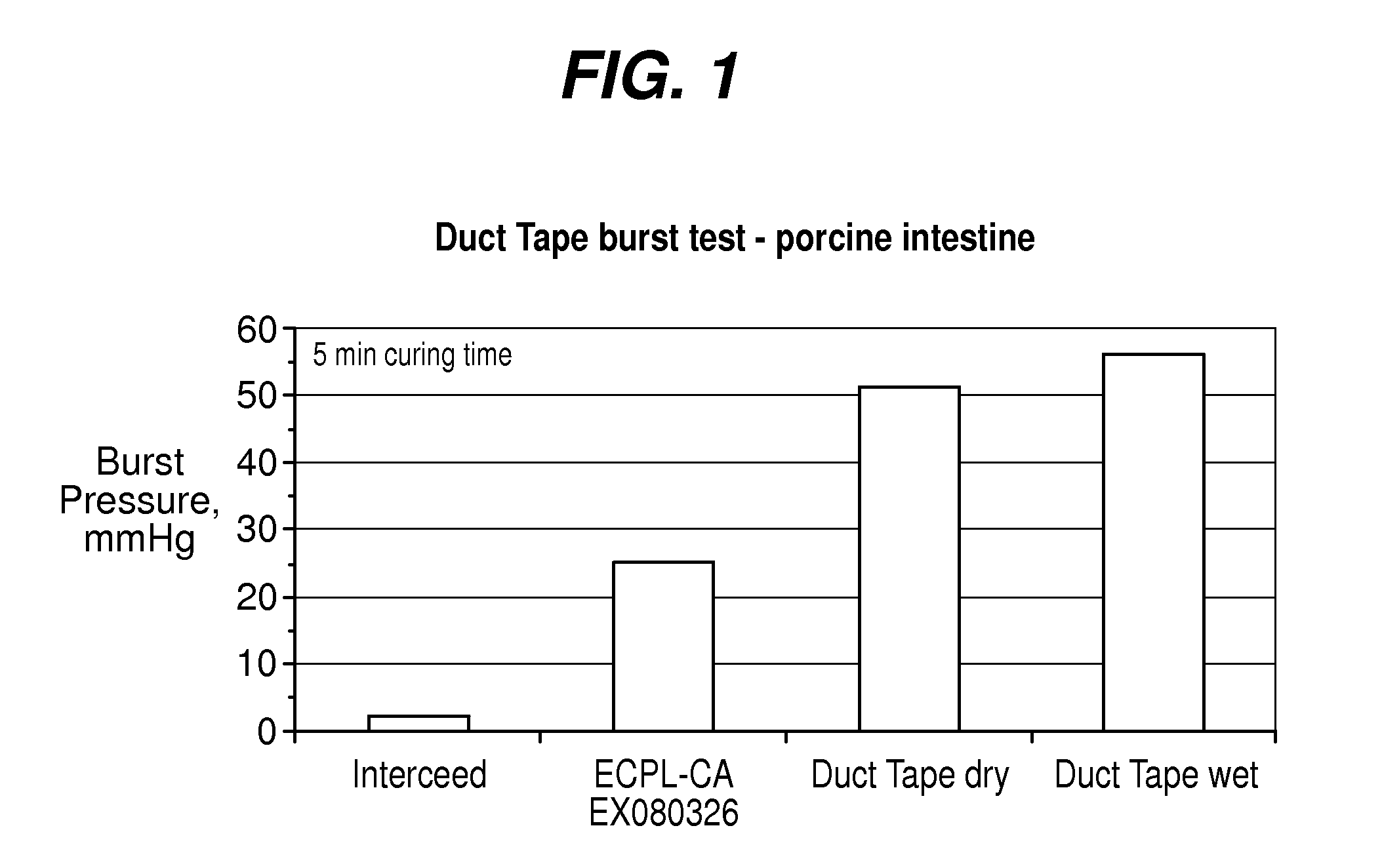Oxidized regenerated cellulose adhesive tape
a technology of oxidized regenerated cellulose and adhesive tape, which is applied in the field of wound closure, can solve the problems of increased morbidity rate, limited use of wound closure devices, and increased trauma to wounds
- Summary
- Abstract
- Description
- Claims
- Application Information
AI Technical Summary
Benefits of technology
Problems solved by technology
Method used
Image
Examples
example 1
Evaluation of the Bonding Capabilities of an ORC Patch Coated with a Cyanoacrylate Adhesive
Materials and Method
[0052]The ORC material chosen was an ORC woven fabric sold under the tradename INTERCEED (Lot# XMB686-3; EXP 2001-09). ORC strips (0.5″×1.5″) were cut from a 3″×4″ sheet then neutralized by immersion for 30 seconds in a bicarbonate solution (1% by weight) before being dried on paper towel.
[0053]The cyanoacrylate adhesive, a biodegradable cyanoacrylate monomer [3-(2-Cyano-acryloyloxy)-hexanoic acid ethyl ester], was synthesized according to the methods described in U.S. Pat. No. 7,238,828B2. Testing was performed on pig organs. A pig was anesthetized according to standard methods. A heating blanket was positioned on the animal's abdomen to keep the body temperature from dropping. As a routine procedure, the pig body temperature was measured via a rectal probe and found to be 97° F. The peritoneal cavity was opened and selected organs (peritoneal wall, small intestine, large ...
example 2
Evaluation of the Wound Closure Capabilities of an ORC Patch Coated with a Cyanoacrylate Adhesive
Materials and Method
[0057]The ORC material chosen was an ORC woven fabric sold under the tradename INTERCEED (Lot# XMB686-3; EXP 2001-09). ORC strips (0.5″×1.5″) were cut from a 3″×4″ sheet then neutralized by immersion for 30 seconds in a bicarbonate solution (1% by weight) before being dried on paper towel. The cyanoacrylate adhesive is a biodegradable cyanoacrylate monomer [3-(2-Cyano-acryloyloxy)-hexanoic acid ethyl ester] as described in Example 1.
Ex-Vivo Testing
[0058]GI burst tests were performed on pig intestine immersed in water at 37° C. A 1 cm incision was performed longitudinally along a piece (approx 6″ long) of intestine and a suture point was placed in the middle of the incision. Four test groups were evaluated for wound closure ability: ORC was used “as is” as negative control; 100 microliters of the cyanoacrylate monomer were dispensed and spread along the approximated ed...
example 3
Evaluation of the Wound Closure Capabilities of an ORC Patch Coated with a Cyanoacrylate Adhesive
Materials and Method
[0061]The ORC material chosen was an ORC woven fabric sold under the tradename INTERCEED (Lot# XMB686-3; EXP 2001-09). ORC strips (0.5″×1.5″) were cut from a 3″×4″ sheet then neutralized by immersion for 30 seconds in a bicarbonate solution (1% by weight) before being dried on paper towel. The cyanoacrylate adhesive is a biodegradable cyanoacrylate monomer [3-(2-Cyano-acryloyloxy)-hexanoic acid ethyl ester] (ECPL-CA) as described in Example 1.
Ex Vivo Testing
[0062]GI burst tests were performed on harvested pig intestine immersed in water at 37° C. A 1 cm incision was performed longitudinally along a piece (approx 6″ long) of intestine and a suture point was placed in the middle of the incision. Three test groups were evaluated for wound closure ability: 100 microliters of sealant ECPL-CA were dispensed and spread along the approximated edges of the wound and over a sur...
PUM
| Property | Measurement | Unit |
|---|---|---|
| temperature | aaaaa | aaaaa |
| temperature | aaaaa | aaaaa |
| bioabsorbable | aaaaa | aaaaa |
Abstract
Description
Claims
Application Information
 Login to View More
Login to View More - R&D
- Intellectual Property
- Life Sciences
- Materials
- Tech Scout
- Unparalleled Data Quality
- Higher Quality Content
- 60% Fewer Hallucinations
Browse by: Latest US Patents, China's latest patents, Technical Efficacy Thesaurus, Application Domain, Technology Topic, Popular Technical Reports.
© 2025 PatSnap. All rights reserved.Legal|Privacy policy|Modern Slavery Act Transparency Statement|Sitemap|About US| Contact US: help@patsnap.com



